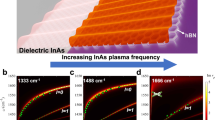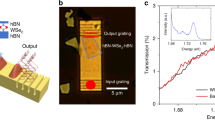Abstract
Surface phonon polaritons (SPhPs) are attractive alternatives to infrared plasmonics for subdiffractional confinement of infrared light. Localized SPhP resonances in semiconductor nanoresonators are narrow, but that linewidth and the limited extent of the Reststrahlen band limit spectral coverage. To address this limitation, we report active tuning of SPhP resonances in InP and 4H-SiC by photoinjecting free carriers into nanoresonators, taking advantage of the coupling between the carrier plasma and optic phonons to blueshift SPhP resonances. We demonstrate state-of-the-art tuning figures of merit upon continuous-wave excitation (in InP) or pulsed excitation (in 4H-SiC). Lifetime effects cause the tuning to saturate in InP, and carrier redistribution leads to rapid (<50 ps) recovery of the resonance in 4H-SiC. This work demonstrates the potential for this method and opens a path towards actively tuned nanophotonic devices, such as modulators and beacons, in the infrared, and identifies important implications of coupling between electronic and phononic excitations.
This is a preview of subscription content, access via your institution
Access options
Access Nature and 54 other Nature Portfolio journals
Get Nature+, our best-value online-access subscription
$29.99 / 30 days
cancel any time
Subscribe to this journal
Receive 12 print issues and online access
$209.00 per year
only $17.42 per issue
Buy this article
- Purchase on Springer Link
- Instant access to full article PDF
Prices may be subject to local taxes which are calculated during checkout




Similar content being viewed by others
References
Koenderink, A. F., Alu, A. & Polman, A. Nanophotonics: shrinking light-based technology. Science 348, 516–521 (2015).
Smith, D. R., Pendry, J. B. & Wiltshire, M. C. Metamaterials and negative refractive index. Science 305, 788–792 (2004).
Adato, R. et al. Ultra-sensitive vibrational spectroscopy of protein monolayers with plasmonic nanoantenna arrays. Proc. Natl Acad. Sci. USA 106, 19227–19232 (2009).
Liu, Z., Lee, H., Xiong, Y., Sun, C. & Zhang, X. Far-field optical hyperlens magnifying sub-diffraction limited objects. Science 315, 1686 (2007).
Dai, S. et al. Subdiffractional focusing and guiding of polaritonic rays in a natural hyperbolic material. Nat. Commun. 6, 6963 (2015).
Li, P. et al. Hyperbolic phonon–polaritons in boron nitride for near-field optical imaging and focusing. Nat. Commun. 6, 7507 (2015).
Homola, J., Yee, S. S. & Gauglitz, G. Surface plasmon resonance sensors: Review. Sens. Acuat. B 54, 3–15 (1999).
Oulton, R. F. et al. Plasmon lasers at deep subwavelength scale. Nature 461, 629–632 (2009).
Kildishev, A. V., Boltasseva, A. & Shalaev, V. M. Planar photonics with metasurfaces. Science 339, 1232009 (2013).
Yu, N. & Capasso, F. Flat optics with designer metasurfaces. Nat. Mater. 13, 139–150 (2014).
Greffet, J.-J. et al. Coherent emission of light by thermal sources. Nature 416, 61–64 (2002).
Wang, T. et al. Phonon–polaritonic bowtie nanoantennas: controlling infrared thermal radiation at the nanoscale. ACS Photon. 4, 1753–1760 (2017).
Koppens, F. H. L. et al. Photodetectors based on graphene, other two-dimensional materials and hybrid systems. Nat. Nanotech. 9, 780–793 (2014).
Basov, D. N., Fogler, M. M. & García de Abajo, F. J. Polaritons in van der Waals materials. Science 354, aag1992 (2016).
Low, T. et al. Polaritons in layered two-dimensional materials. Nat. Mater. 16, 182–194 (2017).
Caldwell, J. D. et al. Low-loss, extreme sub-diffraction photon confinement via silicon carbide surface phonon polariton nanopillar resonators. Nano Lett. 13, 3690–3697 (2013).
Caldwell, J. D. et al. Sub-diffractional, volume-confined polaritons in the natural hyperbolic material hexagonal boron nitride. Nat. Commun. 5, 5221 (2014).
Caldwell, J. D. et al. Low-loss, infrared and terahertz nanophotonics with surface phonon polaritons. Nanophotonics 4, 44–68 (2015).
Dai, S. et al. Tunable phonon polaritons in atomically thin van der Waals crystals of boron nitride. Science 343, 1125–1129 (2014).
Hillenbrand, R., Taubner, T. & Keilmann, F. Phonon-enhanced light–matter interaction at the nanometre scale. Nature 418, 159–162 (2002).
Taubner, T., Korobkin, D., Urzhumov, Y., Shvets, G. & Hillenbrand, R. Near-field microscopy through a SiC superlens. Science 313, 1595 (2006).
Feng, K. et al. Localized surface phonon polariton resonances in polar gallium nitride. Appl. Phys. Lett. 107, 081108 (2015).
Wang, T., Li, P., Hauer, B., Chigrin, D. N. & Taubner, T. Optical properties of single infrared resonant circular microcavities for surface phonon polaritons. Nano Lett. 13, 5051–5055 (2013).
Chen, Y. et al. Spectral tuning of localized surface phonon polariton resonators for low-loss mid-IR applications. ACS Photon. 1, 718–724 (2014).
Khurgin, J. B. & Boltasseva, A. Reflecting upon the losses in plasmonics and metamaterials. MRS Bull. 37, 768–779 (2012).
Schuller, J. A. et al. Plasmonics for extreme light concentration and manipulation. Nat. Mater. 9, 193–204 (2010).
Ferrera, M. et al. Dynamic nanophotonics. J. Opt. Soc. Am. B 34, 95–103 (2016).
Harima, H., Nakashima, S. & Uemura, T. Raman-scattering from anisotropic LO-phonon–plasmon-coupled mode in n-type 4H-SiC and 6H-SiC. J. Appl. Phys. 78, 1996–2005 (1995).
Mooradian, A. & Wright, G. B. Observation of interaction of plasmons with longitudinal optic phonons in GaAs. Phys. Rev. Lett. 16, 999–1001 (1966).
Caldwell, J. D. et al. Free carrier distribution profiling of 4H-SiC substrates using a commercial optical scanner. J. Appl. Phys. 101, 093506 (2007).
Nagai, M., Ohkawa, K. & Kuwata-Gonokami, M. Midinfrared pump–probe reflection spectroscopy of the coupled phonon–plasmon mode in GaN. Appl. Phys. Lett. 81, 484–486 (2002).
Spann, B. T. et al. Photoinduced tunability of the reststrahlen band in 4H-SiC. Phys. Rev. B 93, 085205 (2016).
Long, J. P., Caldwell, J. D., Owrutsky, J. C. & Glembocki, O. J. Actively tunable polar-dielectric optical devices. US patent 9,195,052 (2014).
Karakachian, H. & Kazan, M. Dependence of surface plasmon-phonon-polariton in 4H-SiC on free carrier concentration. J. Appl. Phys. 121, 093103 (2017).
Ellis, C. T. et al. Aspect-ratio driven evolution of high-order resonant modes and near-field distributions in localized surface phonon polariton nanostructures. Sci. Rep. 6, 32959 (2016).
Boudart, B., Prevot, B. & Schwab, C. Free-carrier concentration in n-doped InP crystals determined by Raman-scattering measurements. Appl. Surf. Sci. 50, 295–299 (1991).
Irmer, G., Wenzel, M. & Monecke, J. The temperature dependence of the LO(Γ) and TO(Γ) phonons in GaAs and InP. Phys. Status Solidi B 195, 85–95 (1996).
Liu, A. & Rosenwaks, Y. Excess carrier lifetime in InP single crystals: radiative versus nonradiative recombination. J. Appl. Phys. 86, 430–437 (1999).
Li, K. et al. Wurtzite-phased InP micropillars grown on silicon with low surface recombination velocity. Nano Lett. 15, 7189–1798 (2015).
Ahrenkiel, R. K. et al. Minority-carrier lifetime and photon recycling in n-GaAs. J. Vac. Sci. Technol. A 10, 990 (1992).
Young, J. F. & van Driel, H. M. Ambipolar diffusion of high-density electrons and holes in Ge, Si, and GaAs: many-body effects. Phys. Rev. B 26, 2147–2158 (1982).
Cusco, R., Ibanez, J. & Artus, L. Raman-scattering study of photoexcited plasma in semiconducting and semi-insulating InP. Phys. Rev. B 57, 12197–12206 (1998).
Nakamura, T. & Katoda, T. Effects of optically excited carriers on Raman spectra from InP. J. Appl. Phys. 55, 3064–3067 (1984).
Scajev, P., Gudelis, V., Jarasiunas, K. & Klein, P. B. Fast and slow carrier recombination transients in highly excited 4H- and 3C-SiC crystals at room temperature. J. Appl. Phys. 108, 023705 (2010).
Zollner, S. et al. Dielectric functions of bulk 4H- and 6H-SIC and spectroscopic ellipsometry studies of thin SiC films on SI. J. Appl. Phys. 85, 8353–8361 (1999).
Li, P. et al. Reversible optical switching of highly confined phonon–polaritons with an ultrathin phase-change material. Nat. Mater. 15, 870–875 (2016).
Si, G. et al. All-optical, polarizaton-insensitive light tuning properties in silver nanorod arrays covered with photoresponsive liquid crystals. Phys. Chem. Chem. Phys. 17, 13223–13227 (2015).
Gao, W. et al. Excitation and active control of propagating surface plasmon polaritons in graphene. Nano Lett. 13, 3698–3702 (2013).
Michel, A.-K. U. et al. Using low-loss phase-change materials for mid-infrared antenna resonance tuning. Nano Lett. 13, 3470–3475 (2013).
Yao, Y. et al. Broad electrical tuning of graphene-loaded plasmonic antennas. Nano Lett. 13, 1257–1264 (2013).
Fang, Z. Y. et al. Gated tunability and hybridization of localized plasmons in nanostructured graphene. ACS Nano 7, 2388–2395 (2013).
Ni, G. X. et al. Ultrafast optical switching of infrared plasmon polaritons in high-mobility graphene. Nat. Photon. 10, 244–247 (2016).
Wagner, M. et al. Ultrafast and nanoscale plasmonic phenomena in exfoliated graphene revealed by infrared pump–probe nanoscopy. Nano Lett. 14, 894–900 (2014).
Tiwald, T. E. et al. Carrier concentration and lattice absorption in bulk and epitaxial silicon carbide determined using infrared ellipsometry. Phys. Rev. B 60, 11464–11474 (1999).
Grivickas, P., Linnros, J. & Grivickas, V. Carrier diffusion characterization in 4H-SiC. J. Mater. Res. 16, 524–528 (2001).
Caldwell, J. D. et al. Atomic-scale photonic hybrids for mid-infrared and terahertz nanophotonics. Nat. Nanotech. 11, 9–15 (2016).
Acknowledgements
The authors thank M. Ancona for discussions. A.D.D., C.T.E. and A.J.G. acknowledge support from the National Research Council (NRC)–NRL Postdoctoral Fellowship and Karles Fellowship programmes. This work was funded via the Office of Naval Research through the Nanoscience Institute at the US Naval Research Laboratory.
Author information
Authors and Affiliations
Contributions
J.P.L., I.V., J.D.C., J.C.O. and O.J.G. devised the original concept. A.D.D., C.T.E., J.C.O., J.G.T., J.P.L., O.J.G. and J.D.C. devised the experiment. A.J.G., M.K. and C.S.K. fabricated the samples. A.D.D. and B.T.S. carried out the transient reflectance measurements on SiC nanopillars under the direction of J.C.O. and D.C.R. modelled the results. C.T.E. and J.G.T. carried out the steady-state reflectance measurements on InP nanopillars and I.V. modelled the results. C.T.E. and O.J.G. performed the finite-element method simulations. The project was supervised by J.G.T., J.C.O. and J.D.C.
Corresponding author
Ethics declarations
Competing interests
The authors declare no competing financial interests.
Additional information
Publisher’s note: Springer Nature remains neutral with regard to jurisdictional claims in published maps and institutional affiliations.
Supplementary information
Supplementary Information
Supplementary results and analysis; Supplementary Figures 1–11; Supplementary Table 1.
Rights and permissions
About this article
Cite this article
Dunkelberger, A.D., Ellis, C.T., Ratchford, D.C. et al. Active tuning of surface phonon polariton resonances via carrier photoinjection. Nature Photon 12, 50–56 (2018). https://doi.org/10.1038/s41566-017-0069-0
Received:
Accepted:
Published:
Issue Date:
DOI: https://doi.org/10.1038/s41566-017-0069-0
This article is cited by
-
Near-field detection of gate-tunable anisotropic plasmon polaritons in black phosphorus at terahertz frequencies
Nature Communications (2024)
-
Polariton design and modulation via van der Waals/doped semiconductor heterostructures
Nature Communications (2023)
-
Thermal and electrostatic tuning of surface phonon-polaritons in LaAlO3/SrTiO3 heterostructures
Nature Communications (2023)
-
Incandescent temporal metamaterials
Nature Communications (2023)
-
Manipulating polaritons at the extreme scale in van der Waals materials
Nature Reviews Physics (2022)



